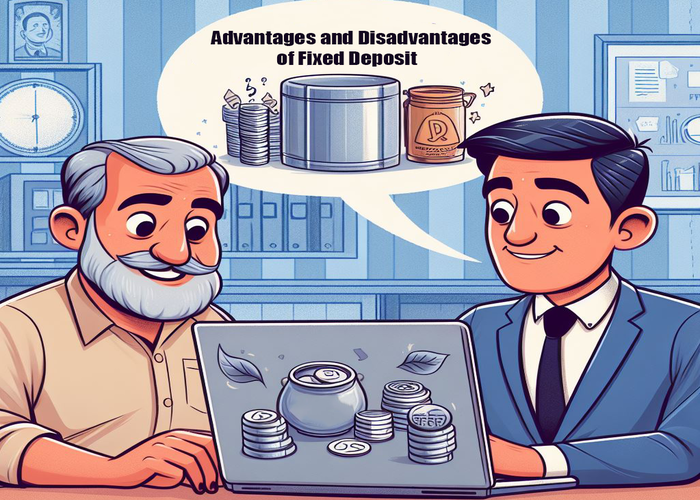Fixed deposits (FDs) have long been a popular investment option for individuals seeking stability and assured returns. However, like any financial instrument, there are both advantages and disadvantages of fixed deposits. Let’s delve into the meaning of fixed deposits and explore their pros and cons to help you make an informed decision about whether they align with your financial goals.
What is a Fixed Deposit?
A fixed deposit (FD) is a financial instrument provided by banks and non-banking financial companies (NBFCs) that allows investors to deposit a lump sum amount for a predetermined period at a fixed interest rate. The interest rate on an FD is typically higher than that on a regular savings account, and it remains constant throughout the deposit tenure, irrespective of market fluctuations. Upon maturity, the investor receives the principal amount along with the accrued interest.
Fixed deposits are known for their simplicity and predictability, making them an attractive option for conservative investors who prioritize capital preservation and steady returns over high-risk, high-reward investment opportunities.
Now, lets move ahead towards the pros and cons of fixed deposits to better understand this investment option.
Advantages of Fixed Deposits
Safety and Stability
One of the primary advantages of fixed deposits is their safety and stability. Unlike riskier investment options such as stocks or mutual funds, FDs are typically offered by banks and are backed by government regulations and deposit insurance schemes. This makes them a reliable choice for preserving capital and safeguarding against market fluctuations.
For instance, in countries like India, fixed deposits in banks are insured by the Deposit Insurance and Credit Guarantee Corporation (DICGC) up to a certain limit. This insurance provides an additional layer of security, ensuring that even if the bank faces financial difficulties, the investor’s funds are protected up to the insured amount.
Assured Returns
Fixed deposits offer a fixed rate of interest for a predetermined period, providing investors with certainty regarding their returns. This makes FDs an attractive option for individuals seeking predictable income streams or those with short to medium-term financial goals. The interest rate on FDs is locked in at the time of investment and remains unaffected by subsequent changes in market interest rates.
This assured return feature is particularly beneficial during times of economic uncertainty or market volatility, as investors can rely on the fixed income generated from their FDs without worrying about market downturns.
Flexibility and Liquidity
While fixed deposits are known for their fixed tenure, many banks offer flexible options such as premature withdrawal or partial withdrawals in case of emergencies. Additionally, FDs can serve as collateral for loans, providing liquidity without the need to break the deposit prematurely.
For example, if an investor requires funds urgently, they can either take a loan against their FD or opt for a premature withdrawal, albeit with some penalty on the interest earned. This flexibility ensures that investors are not completely locked out of their funds in times of need.
Tax Benefits
In many countries, interest earned on fixed deposits is eligible for tax benefits up to a certain limit. This can result in tax savings for investors, especially those in higher tax brackets, enhancing the overall returns on their investment.
For instance, in India, investors can claim a tax deduction of up to INR 1.5 lakh under Section 80C of the Income Tax Act for investments in fixed deposits with a tenure of five years or more. This not only reduces the taxable income but also encourages long-term savings.
Disadvantages of Fixed Deposits
Low Returns
While fixed deposits offer safety and stability, they often come with lower returns compared to other investment options such as equities or real estate. In an environment of low interest rates, the real returns on FDs may be eroded by inflation over time, leading to reduced purchasing power.
For example, if the inflation rate is higher than the interest rate earned on an FD, the real value of the returns diminishes, effectively reducing the investor’s purchasing power. This is a significant drawback for those looking to grow their wealth over time.
Lack of Flexibility
Once invested, funds in fixed deposits are locked in for the duration of the deposit term. Premature withdrawal may incur penalties or forfeit a portion of the interest earned, limiting liquidity and flexibility for investors.
For instance, if an investor decides to break their FD before maturity, they might have to pay a penalty, which is usually a reduction in the interest rate by a certain percentage. This penalty can sometimes negate the benefits of having invested in an FD in the first place.
Inflation Risk
Fixed deposits may not always keep pace with inflation, especially during periods of high inflation. This can erode the real value of returns over time, reducing the purchasing power of invested funds and impacting long-term financial goals.
For example, if an FD offers a 5% annual interest rate but the inflation rate is 6%, the investor is effectively losing 1% in real terms each year. Over time, this negative real return can significantly impact the investor’s wealth.
Opportunity Cost
By allocating funds to fixed deposits, investors may miss out on potential opportunities for higher returns offered by other investment avenues. Depending on individual risk tolerance and investment objectives, foregoing potential growth opportunities in favor of FDs may result in missed wealth accumulation.
For instance, equities have historically provided higher returns over the long term compared to fixed deposits. By choosing to invest in FDs, investors might miss out on the wealth-building potential of the stock market.
Diversifying with Fixed Deposits
Despite their drawbacks, fixed deposits can play a crucial role in a diversified investment portfolio. For risk-averse investors or those nearing retirement, FDs provide a safe haven for capital preservation. Here’s how to integrate fixed deposits into a broader investment strategy:
Emergency Fund: Allocate a portion of your savings to fixed deposits to serve as an emergency fund. This ensures that you have a safety net that is easily accessible in case of financial emergencies without exposing the funds to market risks.
Balancing Risk: Combine fixed deposits with higher-risk investments like stocks or mutual funds to balance overall portfolio risk. The stable returns from FDs can offset potential losses in riskier investments, providing a more balanced and resilient investment strategy.
Goal-Based Investing: Use fixed deposits for specific short to medium-term financial goals, such as saving for a child’s education, a down payment on a house, or a planned vacation. The fixed nature of FDs ensures that the funds grow at a steady rate, aligning with the timelines of these goals.
Alternatives to Fixed Deposits
While fixed deposits are a safe and reliable investment option, exploring alternative investment avenues can help in achieving higher returns and diversifying risk. Here are some alternatives to consider:
Mutual Funds: Mutual funds pool money from multiple investors to invest in a diversified portfolio of stocks, bonds, or other securities. They offer the potential for higher returns compared to fixed deposits but come with a higher risk.
Stocks: Investing in individual stocks can provide significant returns, especially over the long term. However, stocks are subject to market volatility, and investors need to conduct thorough research and have a higher risk tolerance.
Bonds: Bonds are debt securities issued by governments or corporations to raise capital. They offer fixed interest payments and can be a good alternative for those seeking stable income with lower risk compared to stocks.
Real Estate: Real estate investments can provide rental income and potential capital appreciation. However, they require a significant initial investment and involve risks related to property market fluctuations.
Peer-to-Peer Lending: One of the best alternatives to fixed deposits is P2P lending. Platforms like Monexo offer peer-to-peer lending opportunities where investors can lend money to individuals or small businesses in exchange for interest payments. This can provide higher returns compared to fixed deposits, but it also carries credit risk.
Conclusion
Fixed deposits offer a range of benefits, including safety, assured returns, and tax advantages, making them a popular choice for risk-averse investors and those seeking stability in their investment portfolio. However, it’s essential to weigh these advantages and disadvantages of fixed deposits before making the investment. Depending on your financial goals, risk tolerance, and time horizon, fixed deposits can serve as a valuable component of a diversified investment strategy.
As with any investment decision, conducting thorough research and seeking professional advice can help you make informed choices that align with your unique financial circumstances. Additionally, platforms like Monexo.co provide alternative investment options that individuals can consider alongside fixed deposits to optimize their portfolio for growth and stability. By balancing the safety of fixed deposits with the growth potential of other investments, you can achieve a well-rounded and resilient financial strategy.




